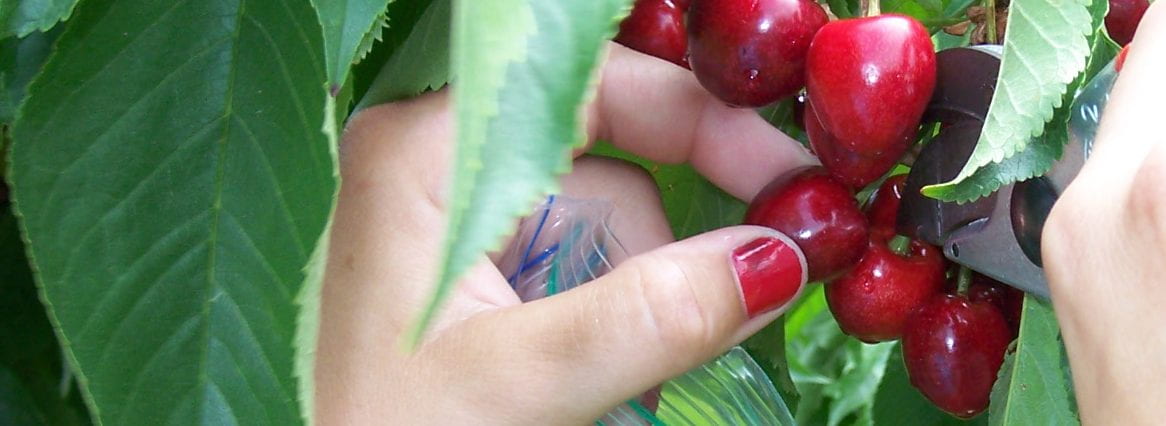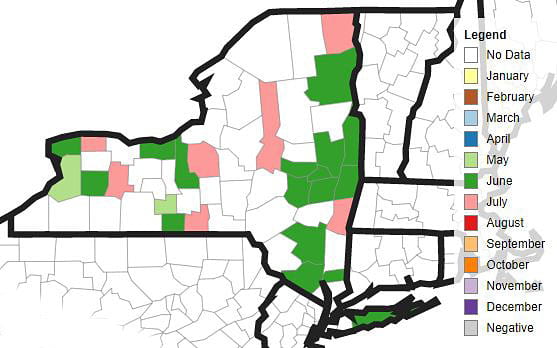Sustained SWD catch was obtained over the last couple of weeks in several counties — Dutchess 1 SWD, Herkimer 6 SWD, Livingston 18 SWD, Onondaga 16 SWD, Orleans at two farms 11 and 9 SWD, and Tioga 1 SWD. Last month, I missed reporting sustained catch in Erie County on June 6, 1 female SWD. Blueberries, raspberries, cherries, gooseberries, currants and many other fruits are being harvested and many will continue with harvests extending over the next several weeks.
Risk from SWD infestation will be high from this point forward in the growing season. Monitor your crops for infestation by taking a sample of fruit at each harvest period and doing a salt flotation test on it. Methods described in Guidelines for Checking Fruit for SWD Larvae in the Field by Laura McDermott, available on Cornell Fruit Resources Monitoring SWD page, fruit.cornell.edu/spottedwing/monitoring/.

Look for signs of infestation in fruit in the field -- look for symptoms of leaky fruit; tiny drops of juice on otherwise perfect fruit; red stains on raspberry fruit receptacles that would otherwise be white; flat, sunken, and dull spots or dimples on fruit surfaces; distorted and disintegrating fruit; leaves stained with juice that has leaked from infested fruit.
Protect ripe and ripening fruit crops from infestation with an insecticide program. Choose a material with excellent efficacy against SWD and an appropriate days-to-harvest interval. Download the Quick Reference Guide to SWD Insecticides at
www.hort.cornell.edu/fruit/pdfs/swd/berry-insecticides.pdf for berries
www.hort.cornell.edu/fruit/pdfs/swd/treefruit-grape-insecticides.pdf for stone fruit and grapes
Details about each County's sustained catch:
- Dutchess: 7/16/2019, 1 female, raspberry – total 1
- Erie: 6/6/2019, 1 female, blueberry – total 1
- Herkimer: 7/15/2019, 2 females & 4 males, blueberry – total 6
- Livingston: 7/25/2019, 7 females & 11 males, tart cherry – total 18
- Onondaga: 7/16/2019, 7 females & 9 males, blueberry – total 16
- Orleans: 7/29/2019, 10 females & 1 male, raspberry – total 11
- Orleans: 7/29/2019, 7 females & 2 male, raspberry – total 9
- Tioga: 7/17/2019, 1 female & 0 males, blueberry – total 1
The sustained catch in Tioga County of only 1 SWD in the blueberries after the prior week’s catch of 26 underlines the impact of an insecticide program on SWD populations.
Thank you for monitoring SWD in the Counties with sustained catch!
- Peter Jentsch and Lydia Brown, Hudson Valley Research Laboratory (Dutchess County)
- Sharon Bachman, CCE of Erie County (Erie County)
- David Thorp, CCE of Livingston County (Livingston County)
- Shona Ort and Barb Neal, CCE of Chemung County and CCE of Tioga County (Tioga County)
- Elizabeth Tee, Lake Ontario Fruit Program (Orleans County)
- Ryan Parker and Juliet Carroll, CCE NYS IPM Program (Herkimer and Onondaga County)
This wraps up monitoring for this year.











